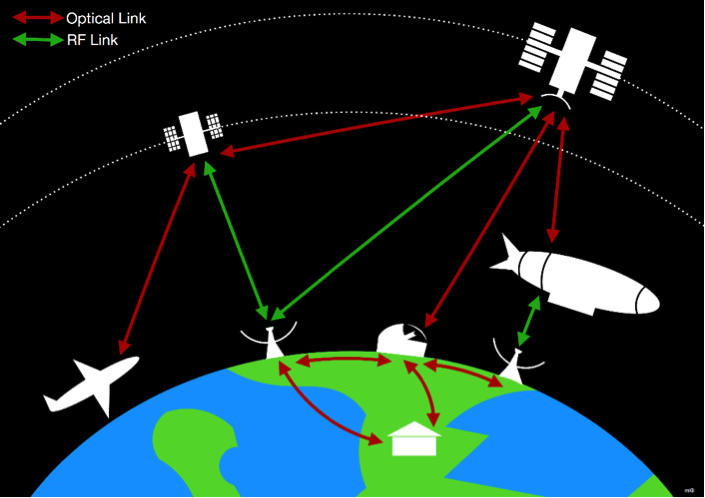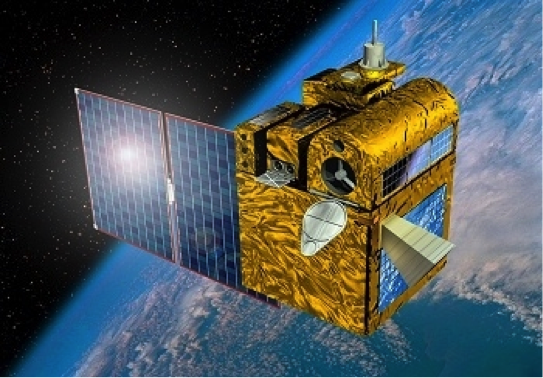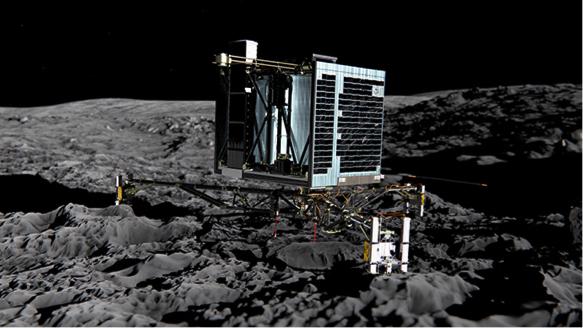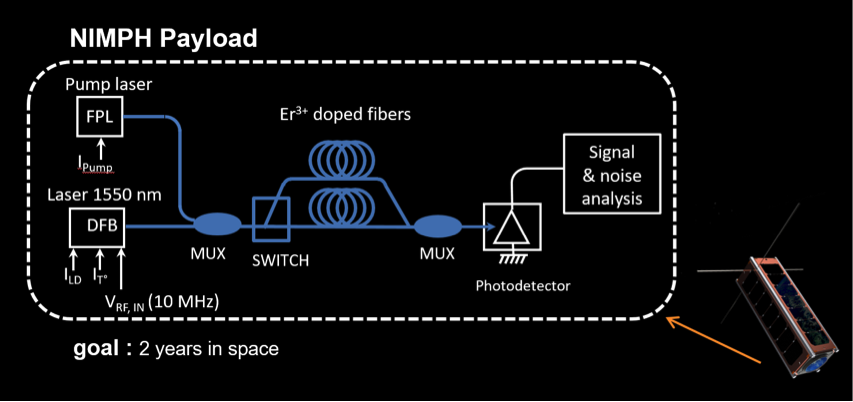Space Axis: Innovative devices and system approaches for space applications
Manager : Olivier Llopis Deputy Manager : Pascal Berthou
Space is a major field of research and development in Toulouse region. The main goals are both industrial and scientific. The national center for space studies (CNES), close to the LAAS, is in charge of the main national satellite missions and is in direct relation with ESA for European space programs. Two main European industry plants for satellites design and integration are located in Toulouse: Thales Alenia Space and Airbus Defense and Space. The CNES and these two societies collaborate with Toulouse academic laboratories for innovation, and thus to perform research directly related to their activity but upstream compared to their main field. They also rely on a small factories network to realize specific devices or to develop a know-how they do not have internally.
Since it has been created, the LAAS is largely involved in this field. In 1968, the “Laboratory for Automation and its Space Application” was created mainly with objectives in space robotics and spacecraft control. Then, the LAAS has increased in size and the number of thematic fields has grown with the laboratory. The new departments have also been involved in research for space applications, particularly thanks to the financial help of its above cited main actors for PhD thesis.
The applications are either industrial (ex: telecommunications) or scientific (ex: space exploration & observation). Our contribution is justified by the requirement in performance and reliability of space systems, and this from a single device to the whole system. This is specific of space industry compared to the other industrial fields where the costs reductions remain too often the main objective.
System performance is thus one of the main parameter for space applications. It can be a performance in terms of energy consumption, signal quality (signal to noise, spectral resolution), compactness… Reliability is the second parameter since no human intervention is possible on most of satellites and space probes. A lifetime of at least 10 years is mandatory (and if possible 20 years) for systems which are submitted to extreme conditions in terms of radiations or temperature changes. Reliability can be optimized through a special design of the system hardware and software components.
Data transmission problems between satellite and earth or between two satellites offer new opportunities of research. Distant planetary probes require specific scheduling and modeling, and this is also the case of some critical tasks at low orbit (space rendezvous, space waste control…). Our impact on these fields is detailed hereafter.
Space telecommunications

Space is a major field of research and development in Toulouse region. The main goals are both industrial and scientific. The national center for space studies (CNES), close to the LAAS, is in charge of the main national satellite missions and is in direct relation with ESA for European space programs. Two main European industry plants for satellites design and integration are located in Toulouse: Thales Alenia Space and Airbus Defense and Space. The CNES and these two societies collaborate with Toulouse academic laboratories for innovation, and thus to perform research directly related to their activity but upstream compared to their main field. They also rely on a small factories network to realize specific devices or to develop a know-how they do not have internally.
Since it has been created, the LAAS is largely involved in this field. In 1968, the “Laboratory for Automation and its Space Application” was created mainly with objectives in space robotics and spacecraft control. Then, the LAAS has increased in size and the number of thematic fields has grown with the laboratory. The new departments have also been involved in research for space applications, particularly thanks to the financial help of its above cited main actors for PhD thesis.
The applications are either industrial (ex: telecommunications) or scientific (ex: space exploration & observation). Our contribution is justified by the requirement in performance and reliability of space systems, and this from a single device to the whole system. This is specific of space industry compared to the other industrial fields where the costs reductions remain too often the main objective.
System performance is thus one of the main parameter for space applications. It can be a performance in terms of energy consumption, signal quality (signal to noise, spectral resolution), compactness… Reliability is the second parameter since no human intervention is possible on most of satellites and space probes. A lifetime of at least 10 years is mandatory (and if possible 20 years) for systems which are submitted to extreme conditions in terms of radiations or temperature changes. Reliability can be optimized through a special design of the system hardware and software components.
Data transmission problems between satellite and earth or between two satellites offer new opportunities of research. Distant planetary probes require specific scheduling and modeling, and this is also the case of some critical tasks at low orbit (space rendezvous, space waste control…). Our impact on these fields is detailed hereafter.
Fig. 1: Future of space communications, with the combination of RF and optical technologies, the use of various transmission media (geostationary satellite, low orbit satellites and stratospheric balloon) together with a high ability to reconfigure terrestrial and space networks
The spacecraft platform
The spacecraft platform provides the fundamental functions for the payload. It poses specific problems such as energy management (generation and storage) or as orbit and attitude control through the GNC (Guidance, Navigation, Control) system among others issues. The need for extended autonomy is obvious when it comes to interplanetary or deep space mission. For instance, Rosetta exploration probe is the perfect example for which the communication delay makes impossible its control by the ground. In this particular case, a LAAS research team has shown their skills by providing to the mission an optimized schedule to perform a number of scientific tasks in a context of limited energy.
 On a broader frame, the onboard energy management of the satellite platform is also an issue in which the Space axis can develop skills since energy components, process optimization are domains of expertise of the LAAS. On this particular point tight collaborations with the Energy axis are envisaged.
On a broader frame, the onboard energy management of the satellite platform is also an issue in which the Space axis can develop skills since energy components, process optimization are domains of expertise of the LAAS. On this particular point tight collaborations with the Energy axis are envisaged.
In addition, the problems of guidance and attitude and orbit control are present in all space systems.
Whether the context is the telecom or observation satellites, mastering these issues gives a competitive advantage in the space market. The LAAS has a long-standing expertise on these topics. For example, adaptive control laws have been designed and validated in flight on PICARD satellite. In addition, collision analysis numerical tools or mission planning algorithms have also been developed. Lastly, optimization-based control laws have been developed taking into account the specificities and constraints of on-board computing in the aim to embedded them in a spaceflight-certified FPGA processor with a LEON 3 architecture. "Hardware-in-the-loop" demonstrator consisting of the LEON 3 board performing the calculations and a space environment simulator has been realized.
From the point of view of navigation, development of specific high-performance sensors, including high precision clocks for instance, is a scientific and technological challenge since they allow the fine positioning of the satellite or the probe. These positioning sensors must sometimes be coupled with other sensors to succeed, for example, a spacecraft rendezvous. Both problems of instrument design and fusion of multi-sensors data for observation and the state of the satellite or its environment are investigated in different LAAS teams.
Fig. 2: Attitude adaptive control of Piccard satellite
Space observation and exploration
The LAAS teams are involved in the design of high-performance sensors in the optical or terahertz domains, of embedded radars, lidars, and high-resolution spectrometers, or of elements of such systems (filters, frequency sources...). These activities could be reinforced by collaborations at the local level, for instance with laboratories in charge of astronomical instruments. In particular, the search for extra-terrestrial biological activities or for complex chemical elements constitutes a very motivating challenge. Such search can be carried out by a robot, on Mars or on any other object of the solar system likely to harbor complex chemical reactions (satellites of Jupiter or Saturn, for example). The biochip approaches developed in the lab for medical applications may be applied to such problems.

Fig. 3: Philae module of the Rosetta mission, for which LAAS contributed to the task scheduling problem
Reliability
The reliability of components and systems is essential in all space applications. It involves lengthy qualification studies and the use of robust approaches during the design phases. This work is conducted today at LAAS both at the component and system levels. The recent technologies of components (i.e. GaN, SiGe ...) are studied under various stress conditions (radiations, RF and DC electrical stress...).
The electronic components must be sufficiently robust, redundant and resilient to electromagnetic compatibility problems. Digital systems must be fault tolerant, especially with respect to local damage caused by high energy particles. Since many years, LAAS deals with the dependability, safety, health analysis and reconfiguration of satellite systems.
Applied to space systems, those systems must provide resilience capabilities in a context of increased autonomy. By gathering both component and system issues around reliability, LAAS has a particularly original place in this work.
Satellite miniaturzation
Whil e geostationary telecommunications satellites have grown in size and complexity these last years, in order to be able to fulfill their mission of higher bit rate and wider and reconfigurable ground cover, other space systems have had an opposite evolution, at least for their dimensions. The satellite clusters at low orbit consists of networks of mini-satellites, each one featuring a mass less than 100 kg. Nanosatellites or cubesat (the basic element being a cube of 10 cm on the side), with a mass lower than 10 kg, are in charge of more and more complex missions. They represent projects that are at the size of a laboratory, or may be of a single team, and are used today also in educative programs, particularly in the frame of the Toulouse University Center for Space (CSUT) which federates the works on various nanosatellites projects. Finally, it is possible that miniaturization can go further and that tomorrow satellites with mass of a few hundred grams but nevertheless operational can be proposed. LAAS is well positioned to participate in this evolution. Original approaches can be proposed, both for system integration or for payloads (electronic or photonic devices qualification in space, bio sensors in microgravity…). As an example, the payload of NIMPH nanosatellite (Nanosatellite to Investigate Microwave Photonics Hardware) is under development at LAAS.
e geostationary telecommunications satellites have grown in size and complexity these last years, in order to be able to fulfill their mission of higher bit rate and wider and reconfigurable ground cover, other space systems have had an opposite evolution, at least for their dimensions. The satellite clusters at low orbit consists of networks of mini-satellites, each one featuring a mass less than 100 kg. Nanosatellites or cubesat (the basic element being a cube of 10 cm on the side), with a mass lower than 10 kg, are in charge of more and more complex missions. They represent projects that are at the size of a laboratory, or may be of a single team, and are used today also in educative programs, particularly in the frame of the Toulouse University Center for Space (CSUT) which federates the works on various nanosatellites projects. Finally, it is possible that miniaturization can go further and that tomorrow satellites with mass of a few hundred grams but nevertheless operational can be proposed. LAAS is well positioned to participate in this evolution. Original approaches can be proposed, both for system integration or for payloads (electronic or photonic devices qualification in space, bio sensors in microgravity…). As an example, the payload of NIMPH nanosatellite (Nanosatellite to Investigate Microwave Photonics Hardware) is under development at LAAS.
Fig. 4: Payload of the nanosatellite NIMPH, currently under development at LAAS (LAAS, UPS and ISAE collaboration). The goal of this payload is to investigate on Er doped optical fibers degradation in space.
